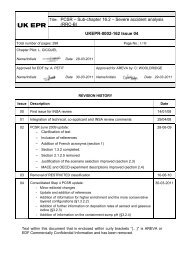Level 3 PSA - EDF Hinkley Point
Level 3 PSA - EDF Hinkley Point
Level 3 PSA - EDF Hinkley Point
You also want an ePaper? Increase the reach of your titles
YUMPU automatically turns print PDFs into web optimized ePapers that Google loves.
HPC-NNBOSL-U0-000-RES-000028 Version 1.0<br />
<strong>Level</strong> 3 <strong>PSA</strong><br />
NOT PROTECTIVELY MARKED<br />
The overall annual risk arising from LOSAs represents an additional 5 % of the SDO-4<br />
BSO.<br />
5.6.5 Worker Cohorts – Risk Summary<br />
According to the current assumptions the most at risk individual worker on site is found<br />
to be the generic worker, with an annual risk that is 36 % of the target of 1 x 10 -6 y -1 set<br />
by SDO-4. The Fuel Building worker cohort is assessed as having a risk which is close<br />
to the generic worker, at around 33 % of the SDO-4 BSO. The MCR worker cohort risk is<br />
only 1/3 of the generic worker cohort risk when including LOSAs.<br />
5.6.6 Effect of Having Two EPR Units on Site<br />
It is possible to make a preliminary estimate of the effect on the overall risk to a generic<br />
worker of having two EPR units on a single site. This effect can be taken into account<br />
simplistically by making the following assumptions, and then re-calculating the overall<br />
risk for the generic worker cohort (In this discussion, the EPR unit at which the generic<br />
worker is employed is referred to as EPR Unit 1 and the adjacent EPR unit on the site is<br />
referred to as EPR Unit 2):<br />
A worker who is employed at EPR Unit 1 will be at risk from the local (in-building)<br />
consequences of accidents occurring at EPR unit 1 (i.e. the local consequences of<br />
<strong>Level</strong> 1 <strong>PSA</strong>, PCC and expert review accidents). The risk arising from LOSAs will<br />
also be unchanged, as in all cases the in-building consequences of accidents and<br />
performance of LOSAs occurring at EPR Unit 2 will have no effect on workers at<br />
EPR Unit 1 [AS-014] and that the occupancy factors used for the calculation shall not<br />
be impacted by a second unit on site [AS-009].<br />
In the case of the on-site consequences of the <strong>Level</strong> 1 <strong>PSA</strong> accidents a worker at<br />
EPR Unit 1 would also be affected by an external (on-site) release from EPR Unit 2,<br />
so the contribution from this source of risk is effectively doubled.<br />
In the case of the PCC and EXRV accidents, a worker at EPR Unit 1 could be<br />
affected by the external release (i.e. on-site consequence) of accidents at EPR Unit<br />
2, but only when the worker is not in a specific building. Therefore, this contribution is<br />
effectively doubled [AS-015].<br />
In the case of the severe (core damage) accidents assessed in the <strong>Level</strong> 2 <strong>PSA</strong>, a<br />
worker at EPR Unit 1 is assumed to be equally affected by accidents occurring at<br />
EPR Unit 2 due to the severity of these accidents and the magnitude of the release,<br />
so the risk contribution from these accidents is effectively doubled [AS-015].A<br />
summary of the risk contributions is shown in Table 7 below.<br />
These results indicate that in terms of risk to an individual worker, the effect of having<br />
two EPR units on the same site is minimal and would lead to a relatively small increase<br />
in risk of the order of 13%. This is due to the fact that the risk to workers is dominated by<br />
the risk arising from being exposed to the radiological release from accidents in the<br />
building where the worker is present. The only significant effect of having two EPR units<br />
on site in terms of worker risk is the effective doubling of the contribution from severe<br />
core damage accidents.<br />
UNCONTROLLED WHEN PRINTED<br />
NOT PROTECTIVELY MARKED<br />
Page 28 of 60














![6.3 - Safety Injection System (RIS [SIS]) - EDF Hinkley Point](https://img.yumpu.com/42739985/1/184x260/63-safety-injection-system-ris-sis-edf-hinkley-point.jpg?quality=85)


